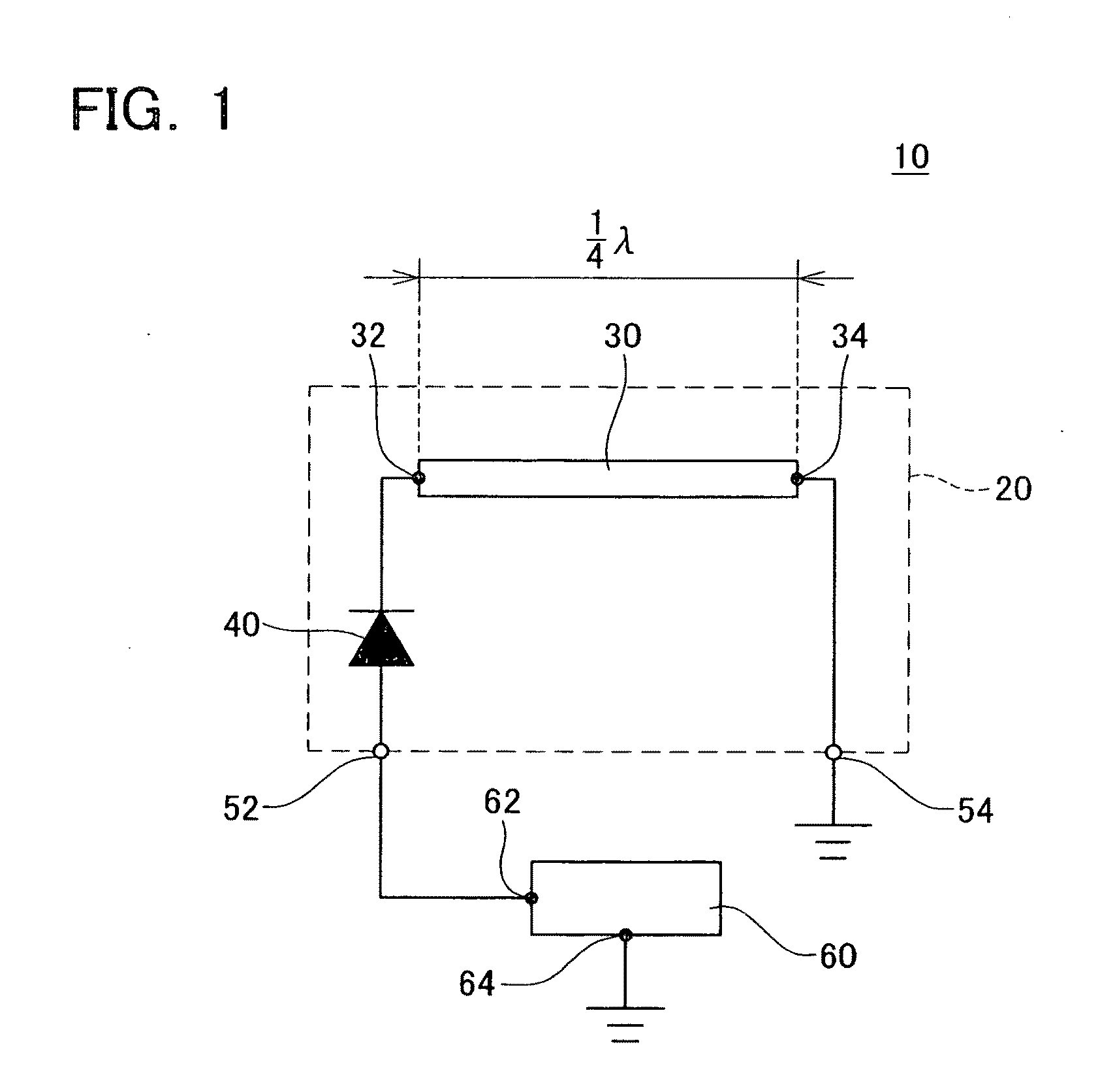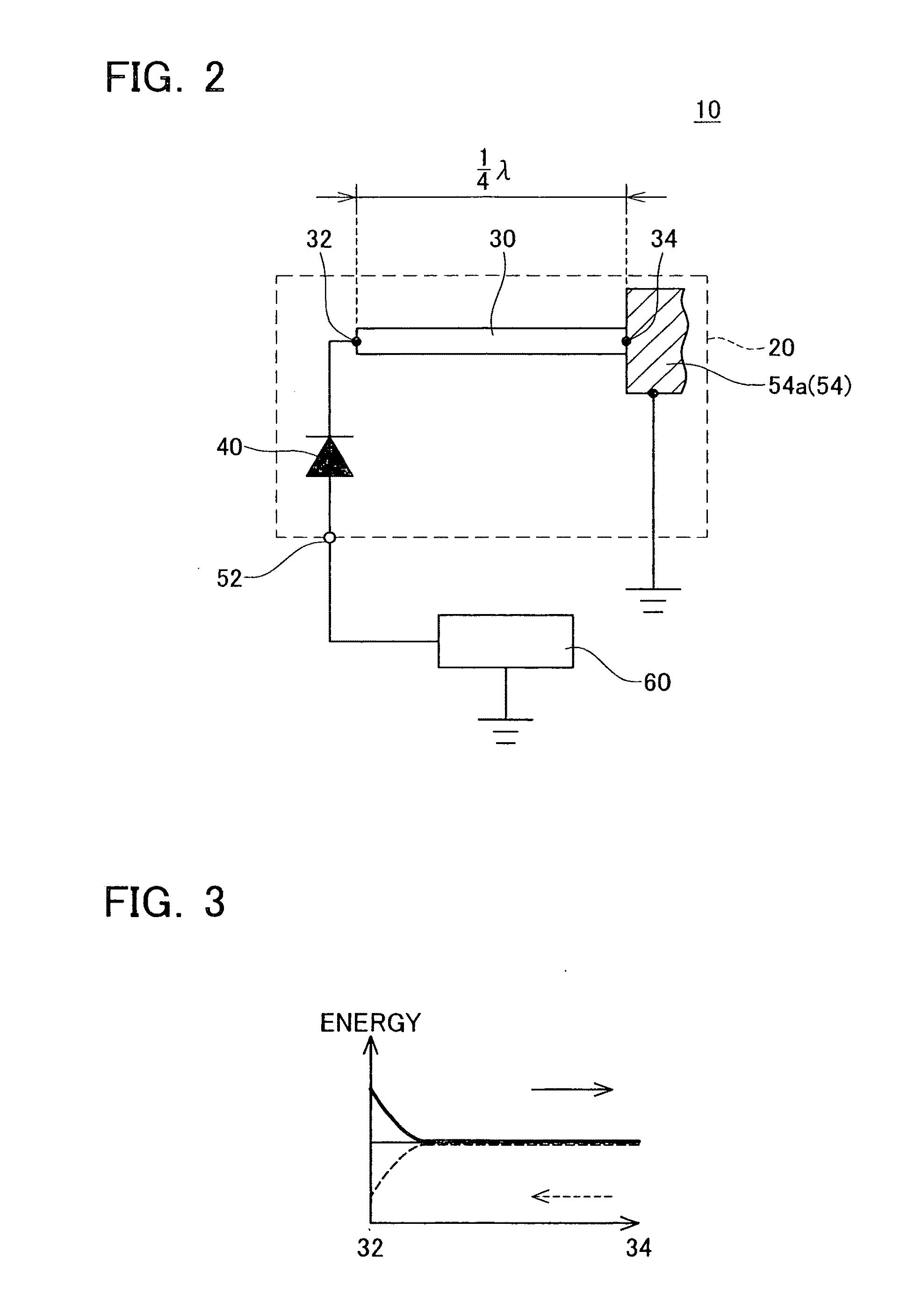Antenna devices
- Summary
- Abstract
- Description
- Claims
- Application Information
AI Technical Summary
Benefits of technology
Problems solved by technology
Method used
Image
Examples
first embodiment
[0054]FIG. 1 shows the configuration of an antenna device 10 for half-wave rectification. The antenna device 10 is provided with an antenna element 20 that supplies current to a load 60. The antenna element 20 has an antenna member 30, a tunnel diode 40, a connecting electrode 52 and a fixed electrode 54.
[0055]The antenna member 30 is electrically conductive and has a linear or flat shape. The antenna member 30 is provided with a portion having a length equal to ¼ of the wavelength λ of light to be received, and the aforesaid portion between one end 32 of that portion (an example of a first portion) and the other end 34 (an example of a second portion) extends along a straight line. The tunnel diode 40 is connected between the one end 32 of the antenna member 30 and the connecting electrode 52, and selectively allows transmission of hot electrons energized to a predetermined energy level. The cathode of the tunnel diode 40 is connected to the one end 32 of the antenna member 30, whi...
second embodiment
[0058]FIG. 4 shows the configuration of an antenna device 100 for full-wave rectification. The antenna device 100 is provided with an antenna element 120 that supplies current to a load 160. The antenna element 120 has an antenna member 130, a first tunnel diode 142, a second tunnel diode 144, a first connecting electrode 152, a second connecting electrode 156, and a fixed electrode 154.
[0059]The antenna member 130 is electrically conductive and has a linear or flat shape. The antenna member 130 is provided with a portion having a length equal to ½ of the wavelength λ, of light to be received, and the aforesaid portion between one end 132 of that portion and the other end 136 extends along a straight line. The portion of the antenna member 130 that extends along the straight line includes a first antenna member 133 and a second antenna member 135. The first antenna member 133 and the second antenna member 135 extend symmetrically with respect to a center portion 134 (and these are e...
example 1
[0065]The following provides a detailed explanation of an antenna device that embodies the technology disclosed in the present specification. Furthermore, the antenna device explained below is used to receive light having a wavelength shorter than that of infrared light, and more specifically, is used to receive light of a wavelength of 2 μm or less. More preferably, the antenna device explained below is used to receive light within the range of infrared light to visible light, and more specifically, is used to receive light of a wavelength within the range of 0.2 to 2 μm. The antenna device explained below can be applied to technologies for wireless transmission and / or reception of electrical power and technologies for generating electrical power from sunlight.
[0066]FIGS. 9A and 9B show the configuration of an antenna element 220 provided in an antenna device of the first example. The antenna element 220 is a basic unit of the antenna device. FIG. 9A schematically shows a longitudi...
PUM
 Login to View More
Login to View More Abstract
Description
Claims
Application Information
 Login to View More
Login to View More - R&D
- Intellectual Property
- Life Sciences
- Materials
- Tech Scout
- Unparalleled Data Quality
- Higher Quality Content
- 60% Fewer Hallucinations
Browse by: Latest US Patents, China's latest patents, Technical Efficacy Thesaurus, Application Domain, Technology Topic, Popular Technical Reports.
© 2025 PatSnap. All rights reserved.Legal|Privacy policy|Modern Slavery Act Transparency Statement|Sitemap|About US| Contact US: help@patsnap.com



